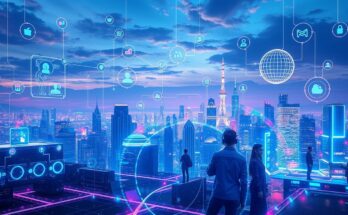The Evolution of Artificial Intelligence: A Journey
Did you know the global AI market will jump from $150.2 billion in 2023 to a huge $1,345.2 billion by 20301? This shows how big AI is getting and why we need to understand its growth. As we look into AI’s history, we see the exciting steps it took to become a key part of our world. It went from just an idea to a big part of many industries today. Here is the detail of The Evolution of Artificial Intelligence.
The story of AI’s growth is more than just a list of dates. It’s about big moments that changed society and the job world. For example, AI might change and create about 40% of jobs worldwide, showing its big impact on work1. This journey through AI’s history covers its early ideas and big breakthroughs.

Key Takeaways
- The global AI market is on track to grow significantly, emphasizing its impact on diverse sectors.
- AI’s journey includes critical transformations, making it vital to grasp its development timeline.
- Understanding early philosophical concepts and key innovators lays a foundation for current AI technologies.
- Anticipating the changes in job roles brings awareness to the evolving landscape of work in an AI-driven world.
- Recognizing AI applications across industries fosters appreciation for its real-world benefits.
Introduction to Artificial Intelligence
Artificial Intelligence (AI) has changed many parts of our lives. It went from just ideas to powerful systems that shape our everyday. In healthcare, AI tools use complex algorithms to look at patient data and make things better. In business, AI changes how things work, letting companies use big data for smarter decisions.
The AI journey started at the Dartmouth Conference in 1956. Researchers talked about “thinking machines” that could solve tough problems2. Since then, AI has grown a lot, reaching new heights with machine learning systems that beat humans in certain tasks3.
Now, AI is part of our daily lives, changing how we use products and services. We see AI in digital assistants like Siri and Alexa, which use natural language to make things easier for us2. These tools show how AI is changing technology, making things more user-friendly and efficient.
- AI in healthcare for better diagnoses.
- AI in business for smarter decisions.
- Digital assistants making things easier for users.
AI does more than just automate tasks; it’s key in looking at huge amounts of data and finding important insights. These insights help shape strategies. As AI keeps getting better, it will likely play a bigger role in many areas, changing how we see technology in our lives.
Theoretical Foundations of AI
The journey into the theoretical foundations of AI shows how early philosophers deeply influenced the study of intelligence and computation. Their philosophical ideas about reasoning and learning were key to building AI’s essential elements. This set the stage for future breakthroughs.
Early Philosophical Concepts
Early philosophers laid the groundwork for AI by exploring human thought mechanisms. Ada Lovelace imagined machines that could work with symbols. Alan Turing then proposed the Turing Machine, which laid out how computers could work. These early thinkers’ ideas are still vital for understanding AI today.
Key Figures in AI History
Many key figures have shaped AI’s history. Alan Turing, John McCarthy, and Donald Hebb each made significant contributions. Their work in the mid-20th century laid a strong foundation for AI research. The Dartmouth Conference in 1956 brought together top AI minds, officially starting the field4. Later, programs like the Logic Theorist showed how machines could reason and expand their capabilities5.
| Influential Thinker | Contribution | Year |
|---|---|---|
| Ada Lovelace | Proposed that machines could manipulate symbols | 1843 |
| Alan Turing | Developed the Turing Machine concept | 1936 |
| John McCarthy | Coined the term “Artificial Intelligence” | 1956 |
| Herbert A. Simon | Created the Logic Theorist program | 1955 |
The study of AI’s theoretical foundations is still growing. It draws on the ideas of these early thinkers and pioneers. This foundation supports ongoing innovations in the field4.
The Birth of Artificial Intelligence
The Dartmouth Conference of 1956 is often seen as the start of artificial intelligence. John McCarthy organized this event, bringing together top minds in the field. They coined the term “artificial intelligence” and set the stage for future research6. Marvin Minsky and others played key roles in guiding AI’s early development7.
The Dartmouth Conference of 1956
The Dartmouth Conference was a turning point for AI. It sparked talks on intelligent machines and brought together future leaders7. The goal was to make machines as smart as humans, setting the stage for years of AI innovation7.
Symbolic AI and its Early Applications
Symbolic AI was a big deal in the early days. It used rules to mimic human thinking, showing how computers could solve tough problems. Early examples included systems for proving theorems and playing simple games, laying the groundwork for AI6.
Significant Milestones in the 1950s
The 1950s were a big time for AI. Alan Turing’s 1950 paper asked if machines could think and introduced the Turing Test8. In 1956, Frank Rosenblatt’s perceptron was a big step in neural networks, showing the power of machine learning8. The decade ended with a lot of government funding for AI, especially from the U.S. Department of Defense8. This funding pushed forward innovations that changed AI’s future.
The Evolution of Artificial Intelligence
The 1980s were key in shaping AI’s future. Big steps were made in machine learning and expert systems. This led to a renewed interest in AI research, thanks to the backpropagation algorithm. It was a big deal for neural networks.
Machine Learning Advancements in the 1980s
In the 1980s, researchers worked on making algorithms better for learning. The backpropagation algorithm was a game-changer. It let neural networks learn from mistakes and get better. This was a big step towards making AI more powerful9.
The Rise of Expert Systems
Expert systems became more important in the 1980s too. They tried to make decisions like human experts in fields like healthcare and finance. Using symbolic reasoning, they helped solve complex problems and analyze big data1011.
Neural Networks Growth and Their Impact
Neural networks made big leaps in the 1980s. Thanks to better computers and algorithms, they could handle tough tasks like recognizing patterns and understanding language. This made AI more reliable and opened up new uses in areas like healthcare and finance910.

AI Winter and Its Recovery
The journey of artificial intelligence has faced many challenges, especially during the AI winter. This term describes two major downturns marked by less funding and less public interest. These downturns happened after too much hype and unrealistic hopes. Knowing what led to these downturns helps us understand today’s AI landscape and why people are interested again.
Causes of the AI Winter
The first AI winter was in the late 1970s and early 1980s, and the second was in the late 1980s and early 1990s12. Many things led to these downturns, like technical limits and not having enough good data. This made it hard for researchers to make progress. Their big projects often didn’t work out, making people skeptical. This led to big cuts in funding for AI research and development.
Renewed Interest in AI Research
Things started to change with new strategies in AI that made people interested again. The introduction of expert systems was a big step forward. Then, breakthroughs in machine learning and neural networks helped set the stage for today’s renewed interest in AI. The win of IBM’s Deep Blue over Gary Kasparov in 1996 changed public and institutional views on AI for the better12. Now, making AI ethical and responsible is key to its growth, with a focus on transparency and rules.
As we face future challenges in AI, working together is crucial. Lawmakers, researchers, and industries must collaborate for sustainable growth. This way, we can avoid the problems of past AI winters1312.
AI in the Age of the Internet
The internet age of AI has changed how we use and find information. This has led to a huge amount of data, which is key for AI to learn and improve. The Internet started growing in the early 90s, making room for AI to advance14. By the 2000s, with broadband, the number of Internet users jumped to 55 million, giving AI more data to work with14.
The Explosion of Data and AI Development
Social media and smartphones have created a lot of data, helping AI make big leaps forward. Algorithms can now quickly spot patterns in data that were hard for humans to see15. Cloud computing made it easier to store and process data, sparking innovation. Big tech companies started offering AI tools at lower prices, making them more accessible15.
Key Developments from the 1990s to 2000s
Important events from the internet age include IBM’s Deep Blue beating the chess champion in 1997, showing AI’s real-world uses16. Moving to machine learning over old rules helped AI grow. The early 2000s saw AI move from ideas to real-world use in games, speech, and ads15. By the late 2010s, tools like OpenAI’s ChatGPT showed how AI had gone from ideas to everyday use14.

Recent Advances and Emerging AI Technologies
The world of artificial intelligence is changing fast, especially with new AI advancements in deep learning. These changes are making industries better by improving how they analyze data and automating tasks that used to need a human brain.
Deep Learning Breakthroughs
Deep learning is a part of machine learning that uses complex neural networks to understand data. It’s great at things like image recognition and understanding human language. Convolutional Neural Networks (CNNs) are top-notch at looking at pictures, which is key for image recognition. Recurrent Neural Networks (RNNs) are perfect for handling data that comes in a sequence, like words in a sentence. Reinforcement learning (RL) is also big for things like self-driving cars and robots, showing how deep learning helps in real life17.
Generative AI and Its Applications
Generative AI is leading the charge in new tech, changing how companies make content and handle data. It’s used in chatbots, translation, and understanding feelings in text. Companies see the big benefits of generative models in making things easier and improving how they talk to users. This tech is big news, as 60% of all jobs could be partly automated18.
Future Trends in AI Development
The future of AI looks like it will focus more on Artificial General Intelligence (AGI) and combining different senses. This could change how machines see the world. With AI spending set to jump by 54.4% by 2020, companies are putting money into new tech that fits their goals. Finding the right balance between complex models and easy-to-understand AI is key. This balance is crucial for building trust and making AI decisions clear17.
Conclusion
The journey of AI from theory to everyday life has changed many industries and our daily routines. As we look to the future, we must face the risks AI brings, like deepfakes and biased algorithms19. These can trick people or even cause harm. Governments are now working hard to regulate AI to tackle these issues19.
Teaching AI to K-12 students will help future generations deal with an AI-filled world. It will teach them about AI’s effects and how to use it wisely19. New technologies like Natural Language Generation are showing AI’s power in healthcare, making it better at diagnosing and monitoring patients20.
The future of AI will be shaped by teamwork between humans and machines. Together, they can improve decision-making and help communities19. AI’s success should be judged by how it helps and uplifts people, making sure everyone has equal access and a positive impact20.
FAQ
What is the evolution of artificial intelligence?
Artificial intelligence has grown from a simple idea to a key part of today’s technology. It has seen big steps forward in algorithms and how we use them.
How has AI impacted different sectors in society?
AI has changed many areas like healthcare, entertainment, and business. It automates tasks, makes processes better, and helps with making decisions. This makes it a big part of our lives today.
Who were the key figures in the early development of AI?
Important thinkers like Ada Lovelace, Alan Turing, Warren McCulloch, and Donald Hebb laid the groundwork for AI. Their ideas helped make AI a unique field.
What were the significant milestones in AI development during the 1950s?
The 1950s were big for AI with the Dartmouth Conference and the term “Artificial Intelligence” being coined. Alan Turing came up with the Turing Test, and there were big steps in natural language processing.
What factors contributed to the “AI Winter”?
The “AI Winter” happened because of too high hopes and tough technical problems. This led to less funding and interest in AI research and early AI systems didn’t live up to expectations.
How did neural networks evolve in the 1980s?
The 1980s were big for neural networks with the return of the backpropagation algorithm. This led to systems that thought more like humans and made AI more powerful.
What role does data play in the advancement of AI technologies today?
Today, lots of data from the internet has sped up AI progress. Machine learning uses big datasets to get better and innovate in many areas.
What are some recent advancements in AI technology?
New AI tech includes big leaps in deep learning and generative AI like GPT-3 and GPT-4. Researchers are also looking into AI that can think like a human and use more senses.
Source Links
- The Evolution and Future of Artificial Intelligence | CMU – https://www.calmu.edu/news/future-of-artificial-intelligence
- The History of AI: A Timeline of Artificial Intelligence – https://www.coursera.org/articles/history-of-ai
- Introduction to artificial intelligence – Simple Talk – https://www.red-gate.com/simple-talk/featured/introduction-to-artificial-intelligence/
- Tracing the History and Evolution of Artificial Intelligence – https://www.bairesdev.com/blog/history-of-ai/
- The Evolution of Artificial Intelligence: From Theory to Everyday Applications – https://www.linkedin.com/pulse/evolution-artificial-intelligence-from-theory-everyday-rabbani
- The History of Artificial Intelligence – Science in the News – https://sitn.hms.harvard.edu/flash/2017/history-artificial-intelligence/
- History of artificial intelligence – https://en.wikipedia.org/wiki/History_of_artificial_intelligence
- The birth of Artificial Intelligence (AI) research – https://st.llnl.gov/news/look-back/birth-artificial-intelligence-ai-research
- Evolution of Artificial Intelligence – Iberdrola – https://www.iberdrola.com/innovation/ai-evolution
- The History And Evolution Of Artificial Intelligence – https://alltechmagazine.com/the-evolution-of-ai/
- The Evolution Of AI: Transforming The World One Algorithm At A Time | Bernard Marr – https://bernardmarr.com/the-evolution-of-ai-transforming-the-world-one-algorithm-at-a-time/
- What is AI-winter and how to avoid it – https://telefonicatech.com/en/blog/what-is-ai-winter-and-how-to-avoid-it
- A brief history of AI: how to prevent another winter (a critical review) – https://ar5iv.labs.arxiv.org/abs/2109.01517
- What Does the Internet Tell Us About AI and Its Evolution? – https://www.automox.com/blog/internet-vs-artificial-intelligence
- The Age of Artificial Intelligence: A brief history… – https://www.deloitte.com/mt/en/services/consulting/perspectives/mt-age-of-ai-1-a-brief-history.html
- The Emergence of the Age of AI | OpenMind – https://www.bbvaopenmind.com/en/technology/artificial-intelligence/the-emergence-of-the-age-of-ai/
- Advancements in Artificial Intelligence and Machine Learning – https://online-engineering.case.edu/blog/advancements-in-artificial-intelligence-and-machine-learning
- Understanding Emerging Technology | AI | CompTIA – https://www.comptia.org/content/research/understanding-emerging-technology-artificial-intelligence
- Conclusions – https://ai100.stanford.edu/gathering-strength-gathering-storms-one-hundred-year-study-artificial-intelligence-ai100-2021-3
- The Evolution and Impact of Artificial Intelligence – https://www.linkedin.com/pulse/evolution-impact-artificial-intelligence-rambabu-perumalla




The Australian live shows marked the first time the band carried out
solo in Sydney and Melbourne, also the first Korean band to do
so. It was the band’s first United States solo live performance and their first live performance on the East Coast.
Most states do not enable supplier plates to be utilized by anybody who shouldn’t be affiliated with
the dealership.